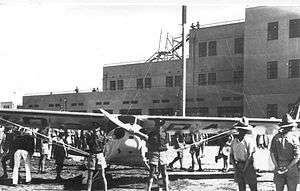RWD 15
| RWD-15 | |
|---|---|
 | |
| Role | Touring aircraft |
| Manufacturer | DWL |
| Designer | RWD team |
| First flight | 1937 |
| Primary users | Poland Romania British Mandate of Palestine |
| Produced | 1939 |
| Number built | 6 |
| Developed from | RWD-13 |
The RWD-15 was a Polish touring aircraft of 1937, designed by the RWD team.
Design and development
The RWD-15 was an enlarged development of the RWD-13 three-seat touring aircraft, designed by Stanisław Rogalski of the RWD team, in the DWL workshops in Warsaw. The prototype first flew in spring 1937 (registration SP-BFX). It inherited RWD-13's advantages, like ease of flying, with good stability. In 1939, five aircraft were produced. A series of 10 RWD-15 was ordered by the Polish Air Force as liaison aircraft in 1939, but they were not completed before the outbreak of World War II. A planned air ambulance variant with two stretchers and an aerial photography version then remained unbuilt.
Description
Five-seater touring strutted high-wing monoplane of mixed construction. Fuselage frame was metal, covered with canvas, the engine section covered with aluminium sheets. A two-spar rectangular wing was of wooden construction, covered with canvas and plywood leading edges, supported by V-struts. Wings were rearwards folding, and were equipped with automatic slats. Cantilever wooden tail unit, covered with plywood (stabilizers) and canvas (rudder and elevators). The cabin was enclosed, with two front seats fitted with dual controls, and behind them a bench with three seats. The cabin had a single door on the left and a pair of doors on the right side, with two luggage compartments at the rear. Engine at the front - 205 hp de Havilland Gipsy Six II, with a two-blade metal tractor propeller (DH Hamilton 1000) of variable pitch, 2.28 m diameter. Conventional fixed landing gear, with a tail-wheel.
Operational history
RWD-15s were used by Polish civilian aviation, and one was used by the Presidential Chancellory. One aircraft (SP-KAT) was completed as a long-range variant, with fuel tanks in place of rear seats, owned by the LOPP paramilitary organization. It was planned to fly it to Australia in marketing goals, but the plans were canceled after the German invasion of Czechoslovakia in March 1939.
In 1939, the prototype RWD-15 was exported to Palestine, and used there by the Aviron aviation company (registration: VQ-PAE, ex. SP-BFX). From 1945, it was used as a communication aircraft on routes from Lod to Tel Aviv and to Egypt. In December 1947, it had to be abandoned in Lod while undergoing repairs, and was burned on 6 April 1948 by Arabs.[1]
After the outbreak of World War II, two aircraft (SP-ALA, SP-KAT) were evacuated to Romania. After the fall of Poland, they were taken over by the Romanian civil aviation (with registration YR-FAN and YR-TIT). After Romania joined the war on Axis side and it took part in attack on the USSR, RWD-15s were used as liaison aircraft on the eastern front by the Romanian Air Force.
According to some publications, one RWD-15 was sent to the 1939 New York World's Fair, along with a RWD-13, and then sold there, but there is no evidence of such aircraft in the US register.[1]
Operators
- Aviron
Specifications
Data from Jane's all the World's Aircraft 1937[2], Polish Aircraft 1893–1939[3], Polskie konstrukcje lotnicze 1893-1939[4]
General characteristics
- Crew: 1
- Capacity: 3 pax
- Length: 9 m (29 ft 6 in)
- Wingspan: 12.4 m (40 ft 8 in)
- Height: 2.5 m (8 ft 2 in)
- Wing area: 20 m2 (220 sq ft)
- Empty weight: 875 kg (1,929 lb)
- Gross weight: 1,360 kg (2,998 lb)
- Fuel capacity: 240 l (63 US gal; 53 imp gal)
- Powerplant: 1 × de Havilland Gipsy Six II 6-cyl inverted air-cooled in-line piston engine, 153 kW (205 hp)
- Propellers: 2-bladed de havilland 1000 (Hamilton) constant-speed metal propeller, 2.28 m (7 ft 6 in) diameter
Performance
- Maximum speed: 240 km/h (149 mph; 130 kn) at sea level
- Cruise speed: 210 km/h (130 mph; 113 kn) at 1,000 m (3,300 ft)
- 220 km/h (140 mph; 120 kn) at 3,000 m (9,800 ft)
- 220 km/h (140 mph; 120 kn) at 3,000 m (9,800 ft)
- Landing speed: 75 km/h (47 mph; 40 kn)
- Range: 1,000 km (621 mi; 540 nmi) with two passengers
- 465 km (289 mi; 251 nmi) with four passengers
- Service ceiling: 5,000 m (16,000 ft) service ceiling
- Rate of climb: 4.8 m/s (940 ft/min)
- Time to altitude: 1,000 m (3,300 ft) in 5 minutes
- Wing loading: 68 kg/m2 (14 lb/sq ft)
- Power/mass: 0.1126 kW/kg (0.0685 hp/lb)
- Take-off distance to 8 m (26 ft): 200 m (660 ft)
See also
Related development
Aircraft of comparable role, configuration and era
References
- 1 2 Stefanicki, Maciej. "Samoloty RWD w Brazylii, Izraelu i USA" (in Polish). Archived from the original on 9 July 2007. Retrieved 20 April 2018.
- ↑ Grey, C.G.; Bridgman, Leonard, eds. (1937). Jane's all the World's Aircraft 1937. London: Sampson Low, Marston & company, ltd. p. 249c.
- ↑ Cynk, Jerzy B. (1971). Polish Aircraft 1893–1939. London: Putnam. pp. 552–555. ISBN 978-0-370-00085-5.
- ↑ Glass, Andrzej (1977). Polskie konstrukcje lotnicze 1893-1939 (in Polish). Warsaw 1977: WKiŁ. pp. 320–322.
External links
| Wikimedia Commons has media related to RWD-15. |
- Photos and drawing at Ugolok Neba site (in Russian)